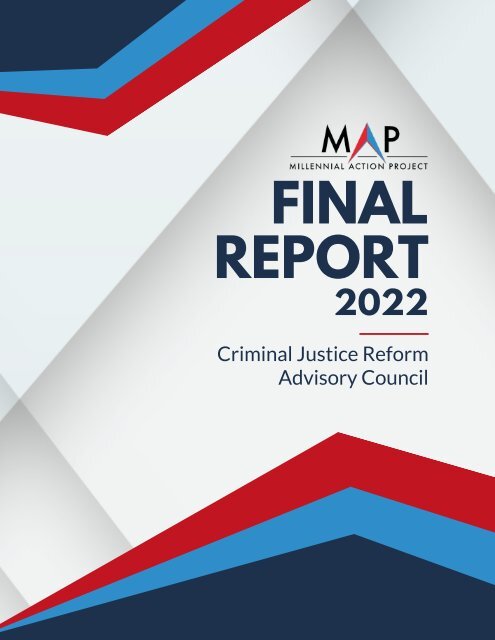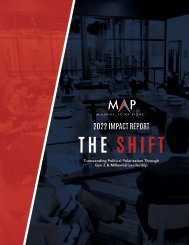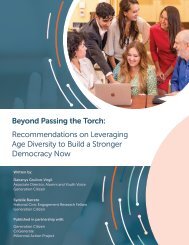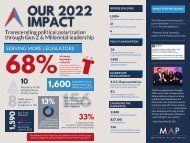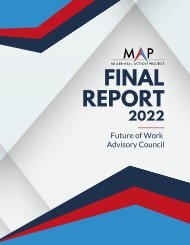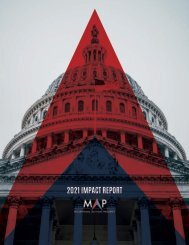Criminal Justice Reform Advisory Council Report 2022
Create successful ePaper yourself
Turn your PDF publications into a flip-book with our unique Google optimized e-Paper software.
FINAL<br />
REPORT<br />
<strong>2022</strong><br />
<strong>Criminal</strong> <strong>Justice</strong> <strong>Reform</strong><br />
<strong>Advisory</strong> <strong>Council</strong>
Table of Contents<br />
01<br />
Foreword p 03<br />
02<br />
Meet the <strong>Advisory</strong> <strong>Council</strong> Members<br />
p 04<br />
03<br />
Introduction<br />
p 05<br />
04<br />
Sentencing <strong>Reform</strong> for Youth<br />
p 06<br />
05<br />
Bail <strong>Reform</strong> for Youth<br />
p 08<br />
06<br />
Youth Miranda Rights<br />
p 09<br />
07<br />
Anti-Recidivism Efforts for Youth p 10<br />
08<br />
Youth Facilities<br />
p 11<br />
09<br />
Parents in the Prison System<br />
p 12<br />
10<br />
Conclusion<br />
p 13
0 3<br />
Foreword<br />
Foreword<br />
In this time of heightened political polarization, few policy areas have seen bipartisan<br />
cooperation as much as criminal justice reform. In red, blue, and purple states, legislators<br />
have grabbed headlines for their efforts to put aside seemingly intractable rivalries to<br />
develop new insights and coalitions that attempt a more equitable system of justice for all<br />
Americans.<br />
There is an urgency to this work. By several measures, the United States maintains one of<br />
the largest incarcerated populations in any developed country. The ramifications of this<br />
fact are staggering on our economy, political system, and society as a whole. <strong>Reform</strong>ers<br />
cannot afford to be thwarted by partisan bickering.<br />
To help provide a framework for legislators to meet and hold discussions on this<br />
important issue, Millennial Action Project launched the second iteration of the <strong>Criminal</strong><br />
<strong>Justice</strong> <strong>Reform</strong> <strong>Advisory</strong> <strong>Council</strong> for the year of <strong>2022</strong>. Convened with the intention of<br />
building on the work of the <strong>Criminal</strong> <strong>Justice</strong> <strong>Reform</strong> <strong>Advisory</strong> <strong>Council</strong> of 2021, this year’s<br />
efforts prioritized in-depth discussions on specialized criminal justice issues, primarily<br />
juvenile justice.<br />
The past few years have seen legislatures across the country move forward with no<br />
shortage of ideas and proposals to overhaul the treatment of our nation’s children within<br />
the criminal justice system. From sentencing reform to bail reform, from protecting<br />
Miranda rights to anti-recidivism policies, the road to a more just future for juvenile<br />
justice remains wide open and ready to be pioneered by young elected officials who have<br />
already brought so much passion and attention to these important topics.<br />
This report details the issues discussed by the CJRAC and the key areas where young,<br />
bipartisan leaders at the state level are seeking to make their voices heard in the<br />
legislative sessions ahead.
Meet the Members<br />
Meet the <strong>Criminal</strong> <strong>Justice</strong><br />
<strong>Reform</strong> <strong>Advisory</strong> <strong>Council</strong><br />
The second iteration of the <strong>Criminal</strong> <strong>Justice</strong> <strong>Reform</strong> <strong>Advisory</strong> <strong>Council</strong> was finalized in early<br />
<strong>2022</strong>. The first meeting was held on May 26th. All of the members on this panel<br />
demonstrate dynamic bipartisan leadership relating to criminal justice reform policies in<br />
their respective legislatures. In the CJRAC’s meetings, these legislators met with outside<br />
experts and had conversations among themselves regarding the status of juvenile justice<br />
reform, building off of the work done by the previous <strong>Criminal</strong> <strong>Justice</strong> <strong>Reform</strong> <strong>Advisory</strong><br />
<strong>Council</strong> in 2021.<br />
This report details approaches to criminal justice policy identified by members of the<br />
<strong>Criminal</strong> <strong>Justice</strong> <strong>Reform</strong> <strong>Advisory</strong> <strong>Council</strong> relating to juvenile justice reform. State<br />
legislator participation on MAP’s Future of Work <strong>Advisory</strong> <strong>Council</strong> does not imply<br />
individual support for any or all of the methods identified in this document.<br />
<strong>Council</strong> Members<br />
Rep. Daniel Pae (R-OK)<br />
Co-Chair<br />
Rep. Jamie Scott (D-AR)<br />
Co-Chair<br />
Rep. Torren Ecker (R-PA)<br />
Sen. Mujtaba Mohammed (D-NC)<br />
Rep. Sara Rasmussen (R-AK) Rep. Leonela Felix (D-RI) Rep. Bobby Cox (R-SC) Rep. Taylor Small (D-VT)
0 5<br />
Introduction<br />
Introduction<br />
The second iteration of the Millennial Action Project’s <strong>Criminal</strong> <strong>Justice</strong> <strong>Reform</strong> <strong>Advisory</strong><br />
<strong>Council</strong> built on the recommendations of the first. Among the most pressing topics<br />
identified for further attention was juvenile justice reform.<br />
Over the course of its meetings, the CJRAC discussed a variety of issue areas and<br />
proposals relating to juvenile justice reform and met with several different issue area<br />
experts. Legislators had an opportunity to strategize with leading organizations and<br />
practitioners to identify areas with the greatest potential for reform.<br />
This report summarizes the research and findings presented to the council members,<br />
including various pieces of bipartisan legislation that can serve as a model for other states.
Sentencing <strong>Reform</strong><br />
Sentencing <strong>Reform</strong> for Youth<br />
Sentencing reform for young offenders can best be summarized as efforts intended to lower the overall number of<br />
incarcerated youth. While incarceration rates have declined, there is still work to be done in reducing demographic<br />
disparities among currently incarcerated youth and limiting youth in adult facilities.<br />
Positive Trends and Legislative Results<br />
Youth Incarceration Rates Nationwide are Decreasing<br />
The Sentencing Project, one of the nation’s leading advocacy groups on justice reform,<br />
found that the number of teenagers committed to juvenile facilities in the U.S. has<br />
fallen almost two-thirds since its peak of 76,000+ in 2000. The Sentencing Project<br />
credits this development to a web of state policies and initiatives ranging from the<br />
promotion of least-restrictive detention options for juveniles to increasing the age<br />
limit for juvenile court jurisdiction.<br />
Causation Legislation<br />
FLHB 885 (Bipartisan, Enacted, 2021): Requires a court to consider specified<br />
information before ordering a child into custody for failure to appear. The intent of<br />
this legislation is to reduce the amount of juvenile detentions based on the state’s<br />
failure to properly communicate with these individuals.<br />
OK HB2311 (Bipartisan, Enacted, 2021) : Prohibits the detention of all persons under<br />
18 years of age in an adult facility except in certain circumstances. The intent of this<br />
legislation is to reduce exposure of juveniles to adult facilities.<br />
Areas for legislative solutions<br />
Racial Disparities in the Juvenile System<br />
Racial disparities in incarceration rates have been a persistent problem in the criminal<br />
justice system. According to the National Association of <strong>Criminal</strong> Defense Lawyers,<br />
juvenile incarceration has proved no different:<br />
Non-white juvenile incarceration rates have have declined at a slower rate<br />
compared to white juveniles;<br />
The racial disparity between black and white youth in custody increased by 22%<br />
from 2001 to 2015;<br />
Black youth accounted for 67.7% of mandatory and discretionary transfers to the<br />
adult prison system in 2016;<br />
On average, judges give 7.8% longer prison sentences to black youth compared to<br />
white youth for the same offenses.
0 7<br />
Sentencing <strong>Reform</strong><br />
Youth in Adult Facilities<br />
In 2019, 2,900 juveniles nationwide were incarcerated in adult jails and 653 were<br />
incarcerated in adult prisons, according to The Sentencing Project. Every year, an<br />
additional 95,000 juveniles are housed in adult jails or prisons. The Equal <strong>Justice</strong><br />
Initiative (EJI), a legal nonprofit that supports underprivileged prisoners, conducted<br />
research that found placing young offenders in adult facilities increases the likelihood<br />
of being sexual assaulted by five times and increases the likelihood a juvenile attempts<br />
suicide by nine times. EJI also writes that many juveniles in the adult criminal justice<br />
system suffer from untreated mental illness, while lacking adequate safeguards in<br />
adult facilities to properly shield them from violence.<br />
Solution-Focused Legislation<br />
ME LD 2 (Partisan, Enacted, 2021): Provides for a study with the eventual goal of<br />
establishing and implementing a system of using racial impact statements for criminal<br />
justice bills during the legislative process.<br />
MD SB165 (Partisan, Not Enacted, <strong>2022</strong>): Prohibits any automatic charging of a youth<br />
offender as an adult in a court of law. The intent of this legislation is to limit the amount<br />
of youth serving in adult facilities.
Bail <strong>Reform</strong><br />
Bail <strong>Reform</strong> for Youth<br />
Bail reform refers to policies that reduce or eliminate financial burdens placed on young offenders through the court<br />
system. Such efforts can focus on either young offenders established as indigent or young offenders as a whole.<br />
Areas for Legislative Solutions<br />
Unaffordable Cash Bail for Young Offenders<br />
The permissibility of cash bail for young offenders has emerged as a topic of growing<br />
concern among criminal justice advocates. Bail for juveniles is mostly determined by<br />
state law. The National Juvenile Defender Center (NJDC) commissioned a report in<br />
2019 to document each state’s practices regarding juvenile bail. This report found that<br />
bail for children was “a matter of pure judicial discretion” with some defense attorneys<br />
reporting bail numbers ranging into the tens- or hundreds-of-thousands of dollars and<br />
no discussion of ability to pay. Even bail as low as $75 presented difficulties for a<br />
family to post. Unaffordable bail was shown to result in longer detentions of children<br />
before trial, separating them from their families based solely on an inability to pay.<br />
Controversy Regarding Bail <strong>Reform</strong>'s Effectiveness<br />
With national concern over the increase in crime rates, bail reform policies have<br />
attracted attention as a potential contributing factor. Opponents of lessening bail<br />
restrictions argue that it leads to a quick release of potential repeat offenders;<br />
however, current evidence points to a mixed conclusion. One analysis of recent bail<br />
reforms conducted by the Prison Policy Institute concluded that after review of 13<br />
jurisdictions: "all but one… saw decreases or negligible increases in crime after<br />
implementing reforms." In contrast, a study conducted by the University of Utah<br />
concluded that bail reforms in Cook County, Illinois, were statistically associated with<br />
subsequent increases in crime rates. Ultimately, the effectiveness of bail reform is<br />
likely to continue to garner debate.<br />
Controversy Regarding Bail <strong>Reform</strong>'s Effectiveness<br />
CO SB21-071 (Bipartisan, Enacted, 2021): Prohibits the imposition of cash or<br />
property-secured bonds for juveniles charged with a delinquent act.<br />
NJ S3319 (Bipartisan, Enacted, <strong>2022</strong>): Eliminates certain juvenile fines, fees, costs, and<br />
other monetary penalties.
0 9<br />
Youth Miranda Rights<br />
Youth Miranda Rights<br />
Legal precedent requires juvenile offenders the right to be read a Miranda warning; however, there have been a number<br />
of obstacles that have raised concerns over the equitability and effectiveness of current Miranda procedures for<br />
juveniles. Among these are concerns over juveniles’ understanding of Miranda procedures, notification of parents, and<br />
determining when a juvenile is in custody.<br />
Areas for Legislative Solutions<br />
Helping Juveniles Understand Miranda Rights<br />
Given the legal and constitutional complexities behind Miranda rights, it is not<br />
surprising that many young offenders simply do not understand these rights and thus<br />
are more likely to waive them and risk self-incrimination during a police interrogation.<br />
The American Bar Association has listed the rate at which juveniles waive their<br />
Miranda rights as high as 90%. The ABA further writes that this dynamic is caused by<br />
multiple factors, such as the socialization of young people to answer questions for<br />
adults and that juvenile offenders tend to have more intellectual disabilities or mental<br />
health disorders that severely impact their judgment. As such, the ABA has thrown<br />
support behind legislation to provide simplified Miranda warnings to young offenders.<br />
Required Contact of Parents or Guardians<br />
While the only constitutionally established Miranda rights are the right to remain<br />
silent and the right to legal counsel, there has been debate over whether these rights<br />
alone are sufficient to ensure due process for juveniles. One potential expansion of<br />
rights for the benefit of young suspects is to enshrine a greater role for parents or<br />
guardians during police interrogation or when a juvenile is in custody. This policy<br />
formed a critical part of Maryland’s Child Interrogation Protection Act which requires<br />
police to make a reasonable effort to contact a child’s parents before an in-custody<br />
interrogation.<br />
Demonstrative Legislation<br />
AZ HB2309: (<strong>2022</strong>, Bipartisan, Passed House) Requires detained juveniles be advised<br />
by a peace officer of their Miranda Rights in comprehensible language before<br />
questioning begins.<br />
MD SB0053: (<strong>2022</strong>, Partisan Bill, Law) Requires the law<br />
enforcement officer who takes a child into custody to provide actual<br />
notice to the child’s parents or guardian, with specific information on<br />
the child’s location and how to make in-person contact.
Anti-Recidivism<br />
Anti-Recidivism Efforts for Youth<br />
Anti-recidivism efforts reduce repeated offenses by juveniles after their initial period in the criminal justice system. Antirecidivism<br />
efforts for youths differentiate from adults by a greater emphasis on education, mentoring, and family support.<br />
Positive Trends and Legislative Results<br />
Preventing Juvenile Recidivism<br />
There has been strong policy evidence about what role states can play in combating<br />
juvenile recidivism. In 1997, the Washington state legislature passed the Community<br />
Juvenile Accountability Act to promote the use of research-based programs to reduce<br />
juvenile crime. Among the programs introduced were Functional Family Therapy<br />
(FFT), which sought to reduce criminal risk factors in an offender’s family, and<br />
Aggression Replacement Therapy (ART), which offered learning techniques to control<br />
impulsive behavior. The Washington State Institute for Public Policy found that 7<br />
years after implementation, FFT was associated with a 38% reduction in felony<br />
recidivism while ART was associated with a 24% reduction. Findings such as these<br />
suggest that increased funding for evidence-based mental health programs may be<br />
crucial to limiting the amount of youth recidivism.<br />
Causation Legislation<br />
WA SB5304 (Bipartisan, Enacted, 2021): Provides societal reentry services to persons<br />
released from state and local institutions, including juvenile detention facilities.<br />
TN HB0240 (Bipartisan, Enacted, 2021): Authorizes counties to develop and operate<br />
transition centers designed to reduce recidivism rates among former offenders.<br />
Areas for Legislative Solutions<br />
Unlike research on adult recidivism rates, juvenile recidivism rates have suffered from<br />
basic gaps in reporting that have in turn led to occasionally inadequate policy responses.<br />
The <strong>Justice</strong> Center at the <strong>Council</strong> of State Governments confirms that up to 20% of state<br />
juvenile corrections agencies don’t track recidivism rates among their populations. The<br />
<strong>Justice</strong> Center provides further recommendations that states should create a system<br />
where pressures towards youth recidivism are combated through the usage of data and<br />
direct system evaluation.<br />
Solution-Focused Legislation<br />
CT SB206 (Bipartisan, Enacted, <strong>2022</strong>): Among other provisions, permits the Court<br />
Support Services of the state Judicial Branch to share common case records for the<br />
purposes of tracking recidivism.<br />
IN HB1359 (Bipartisan, Enacted, <strong>2022</strong>): Provides that the Commission on Improving<br />
the Status of Children in Indiana shall create a statewide oversight body to collect and<br />
report juvenile justice data.
1 1<br />
Youth Facilities<br />
Youth Facilities<br />
Despite the confinement of juvenile offenders having seen a pronounced decline since 2000, efforts have continued to<br />
further reduce the population of young prisoners. Some of these efforts have focused on the quality and safety of youth<br />
detention facilities with the goal of promoting less restrictive confinement as well as closing down unnecessary or<br />
dangerous facilities.<br />
Areas for Legislative Solutions<br />
The Missouri Model<br />
The “Missouri Model” refers to juvenile justice agency policies that promote a shift<br />
away from correctional-style confinement of young offenders and toward smaller,<br />
dorm-like rehabilitative facilities. Research from facility reform organizations such as<br />
the Vera Institute and the Prison Law Office has presented strong evidence that lessrestrictive<br />
confinement models enhance rehabilitation efforts and reduce the harm<br />
incarceration inflicts on those confined. This research has led the Prison Policy<br />
Institute, one of the nation’s leading criminal justice reform organizations, to endorse<br />
the Missouri Model as a pathway to improved facilities for juvenile offenders.<br />
Causation Legislation<br />
Entry into the criminal justice system is often considered one of the most stressful and<br />
challenging experiences among juveniles. For young offenders, these stresses are<br />
compounded by a lack of social and life experiences, and incomplete mental<br />
development. The result, according to the <strong>Justice</strong> Policy Institute, is a disruption of<br />
mental development, a greater risk of self-harm, and an increase in mental disorders<br />
that can have lifelong impacts and push a youth toward recidivism. Like other<br />
organizations, JPI recommends a shift away from a carceral approach to young<br />
offenders in favor of less-restrictive and family or community-based programs that<br />
encourage positive development among juveniles who find themselves on the wrong<br />
side of the law.<br />
Demonstrative Legislation<br />
VA SB108: (<strong>2022</strong>, Bipartisan, Law) Directs the Department of Corrections to convene<br />
a work group to study the use of restorative housing within juvenile correctional<br />
centers.<br />
WA SB5121: (2021, Partisan Bill, Enacted) Expands eligibility for the<br />
state graduated re-entry program for incarcerated individuals in the<br />
state correctional system, including juveniles.
Parents<br />
Parents in the Prison System<br />
The involvement of a child’s parents in the juvenile justice system has been a topic of increased interest as reformers<br />
look for ways to humanize current policies. When a child finds themself in legal trouble, there are few codified guidelines<br />
on what role, if any, their parents are meant to play in supporting their child through the legal process. Recent efforts<br />
have worked to create a more comprehensive role for parents in rehabilitation efforts for a young offender.<br />
Areas for Legislative Solutions<br />
Parents Bill of Rights<br />
One way jurisdictions have sought to codify the role of parents in the juvenile justice<br />
system is the creation of a “parents bill of rights” that succinctly describes what<br />
parents can rightfully expect as they navigate and support their child through the<br />
criminal justice system. The two most prominent jurisdictions to fully adopt this<br />
approach are the District of Columbia and Texas. Texas’ bill of rights guarantees to<br />
parents an opportunity to design and implement a treatment plan for their child from<br />
their initial intake into the criminal justice system to their discharge.<br />
Parents as Partners, not Problems<br />
Research compiled by Northwestern University delineates how the criminal justice<br />
system has taken a low view of parental involvement often based on the assumption<br />
that parental inadequacy is a cause of juvenile delinquency. Northwestern’s research<br />
disputes this assumption, citing that the vast majority of youth in juvenile justice<br />
facilities (85%) are released to a private address; this indicates some type of familial<br />
ties exist for most young offenders. Northwestern’s report further indicates that<br />
active parental involvement in a juvenile offender’s treatment, such as through family<br />
therapy, is associated with a nearly 50% reduction in recidivism.<br />
Demonstrative Policies<br />
Parental Bill of Rights: As mentioned above, DC and Texas are two jurisdictions with<br />
currently-enacted bills of rights for parents as they deal with the juvenile justice<br />
system. In Texas’ case, the implementation of the Bill of Rights was guided by<br />
legislation.<br />
Family Therapy with the Juvenile and Parents: Parents play a key role in the juvenile<br />
justice system for they are the leaders in family-based interventions to promote<br />
rehabilitation for the juvenile offender. Among the most prominent therapies are<br />
Positive Family Support, Functional Family Therapy, and Multisystemic Therapy–<br />
Family Integrated Transitions.
1 3<br />
Conclusion<br />
Conclusion<br />
The ongoing debate over criminal justice reform is not likely to simmer down anytime<br />
soon. Now, more than ever, it is important to highlight and provide support to the work of<br />
young, bipartisan leaders in this field as they work to craft solutions to this pressing issue.<br />
Furthermore, at a time where there has been growing public concern about potential<br />
increases in crime rates, it is also important to emphasize areas of work where there is<br />
conclusive evidence that reform efforts are not tied to any increases in the underlying<br />
crime rate.
1 4<br />
F o l l o w M A P<br />
WWW.MILLENNIALACTION.ORG<br />
@MACTIONPROJECT<br />
@MACTIONPROJECT<br />
@MILLENNIALACTIONPROJECT<br />
/MILLENNIALACTIONPROJECT<br />
@MILLENNIALACTIONPROJECT


